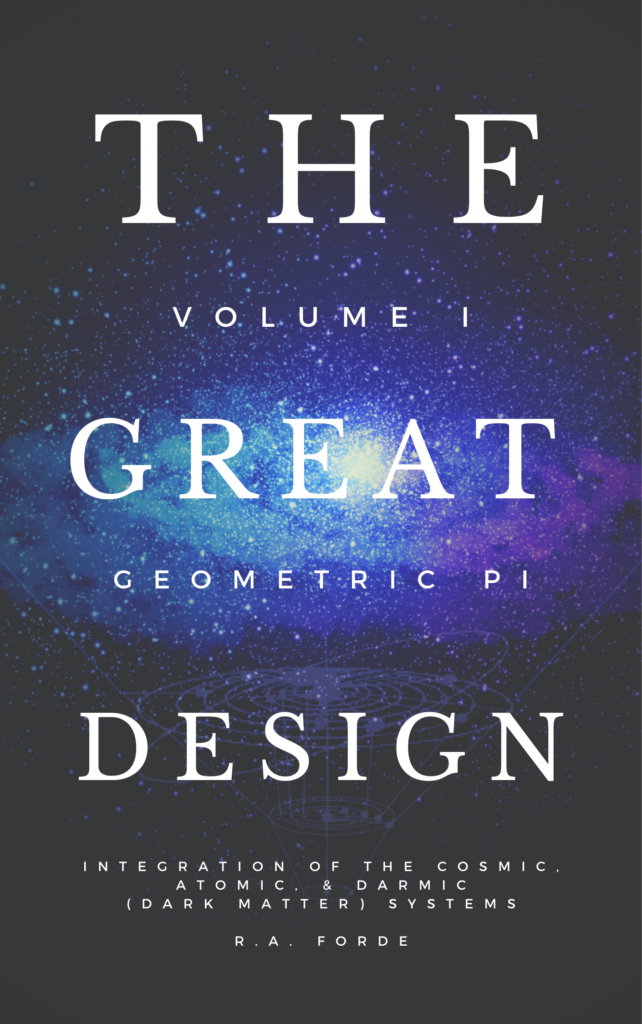The Great Design Vol. 2
Quantum / Atomic Gravity
E=mc2. But, what if light isn’t the universe’s speed limit?
Albert Einstein’s relativity equation, E=mc2, is based on all matter not having the ability to go faster than the speed of light. This equation, in effect, has limited universal physics to the speed of light. But, what if this was wrong – and it could be proven? The Great Design series covers the atomic and darmic (dark matter systems) – and the series of equations developed to calculate atomic and darmic gravitational constants reveal how darmic matter travels billions of times faster than the speed of light. How? Download the Great Design Volume II to see now.

Chapter List
1.0 Introduction
2.0 Cosmic/Atomic Relationship
3.0 Bohr’s Model
4.0 Universal Gravitational Constant, G
5.0 Quantum/Atomic Gravitational Constant, GA
6.0 Atomican Gravitational Force, FA
7.0 Atomic Gravitational Force & Acceleration, ae
8.0 Atomic Centrifugal Foce, fA
9.0 Gravitational Potential Energy
10. Quantum & Universal Gravitational Constants Relationship
11.0 Atomic Electron Average Orbital Velocity
12.0 Atomic & Cosmic Orbital Bodies’ Acceleration Relation
13.0 Atomic Electrical Force, FAE
14.0 Atomic Orbital Period
15.0 Atomic Orbital Frequency
16.0 Mathematical Proof of Quantum Gravity
- 16.1 Gravitation Force Proof
- 16.2 Step 1.0: Sun-to-Proton Scale Down
- 16.3 Step 2.0: Earth-to-Electron Scale Down
- 16.4 Step 3.0: Sun-to-Proton Gravitational Froce
- 16.5 Step 4.0: Earth-to-Electron Radius Distance
- 16.6 Gravitational Constant Change
17.0 Standard Gravitational Parameters – GM Proof
- 17.1 Sun/Earth-to-Proton/Electron Mass Reduction
- 17.2 Earth-to-Electron Orbital Velocity – GM
- 17.3 Earth-to-Electron Radius Distance – GM
- 17.4 GM Proof – Gravitation Constant Change
18.0 Orbital Period Proof
- 18.1 Sun-to-Proton Mass Reduction
- 18.2 Earth-to-Electron Radius Distance
- 18.3 Earth-to-Electron Orbital Period
- 18.4 Gravitational Constant Change
19.0 Mercury Planet Reduction
- 19.1 Gravitation Force Method
- 19.2 Sun/Mercury-to-Proton/Electron Mass Reduction
- 19.3 Mercury-to-Electron Mass Reduction
- 19.4 Sun-to-Proton Gravitational Force
- 19.5 Mercury-to-Electron Radius Reduction
- 19.6 Gravitational Constant Change
20.0 Venus – Standard Gravitational Parameter (GM) Proof
- 20.1 Sun-to-Proton Mass Reduction
- 20.2 Venus-to-Electron Orbital Velocity
- 20.3 Venus-to-Electron Radius Distance Reduction
- 20.4 Gravitational Constant Change
21.0 Mars – Orbital Period Parameters Proof
- 21.1 Sun-to-Proton Mass Reduction
- 21.2 Mars-to-Electron Orbital Period Reduction
- 21.3 Mars-to-Electron Radius Distance Reduction
- 21.4 Gravitation Constant Change
22.0 Jupiter – Acceleration Proof
- 22.1 Jupiter-to-Electron Acceleration
- 22.2 Jupiter-to-Electron Orbital Velocity
- 22.3 Jupiter-to-Electron Radius Distance Reduction
- 22.4 Jupiter-to-Electron Orbital Period
- 22.5 Jupiter-to-Electron Orbital Velocity
- 22.6 Gravitational Constant Change
- 22.7 Earth – Cosmic/Atomic Light Relationship
- 22.8 Mercury – Cosmic/Atomic Light Relationship
- 22.9 Mars – Cosmic/Atomic Light Relationship
- 22.10 Milky Way Galaxy – Cosmic/Atomic Light Relationship
- 22.11 Venus – Cosmic/Atomic Light Relationship
- 22.12 Moon – Cosmic/Atomic Light Relationship
- 22.13 Saturn – Cosmic/Atomic Light Relationship
- 22.14 Uranus – Cosmic/Atomic Light Relationship
- 22.15 Neptune – Cosmic/Atomic Light Relationship
- 22.16 Pluto – Cosmic/Atomic Light Relationship
- 22.17 Eris – Cosmic/Atomic Light Relationship
23.0 Solar System
24.0 Atomic-to-Cosmic Relationship
25.0 Centrifugal Force – Atomic-to-Cosmic Proof
26.0 Quantum Gravity: Atomic-to-Cosmic Relationship
27.0 Saturn Gravitational Potential Energy Proof
- 27.1 Sun-to-Proton Mass Reduction
- 27.2 Saturn-to-Electron Mass Reduction
- 27.3 Saturn-to-Electron Radius Reduction
- 27.4 Saturn-to-Electron Gravitational Potential Energy
- 27.5 Gravitational Constant Change
28.0 Uranus – Orbital Energy Proof
- 28.1 Sun-to-Proton Mass Reduction
- 28.2 Uranus-to-Electron Orbital Energy Reduction
- 28.3 Uranus-to-Electron Radius Distance
- 28.4 Gravitational Constant Change
29.0 Neptune – Orbital Angle Proof
- 29.1 Sun-to-Proton Mass Reduction
- 29.2 Neptune-to-Electron Radius Distance Reduction
- 29.3 Neptune-to-Electron 1/12 Orbital Period
- 29.4 Gravitational Constant Change
- 29.5 Dark Matter Gravitational Constant, Gd Presence
30.0 Pluto Gravitational Force Proof
- 30.1 Sun-to-Proton Reduction
- 30.2 Pluto-to-Electron Mass Reduction
- 30.3 Pluto-to-Electron Radius Reduction
- 30.4 Gravity Force Reduction
- 30.5 Gravitational Constant Change
31.0 Eris Orbital Velocity Proof
- 31.1 Sun-to-Proton Reduction
- 31.2 Eris-to-Electron Orbital Velocity
- 31.3 Pluto-to-Electron Radius Reduction
- 31.4 Gravitational Constant Change
32.0 Moon Orbital Velocity Proof
- 32.1 Earth-to-Proton Mass Reduction
- 32.2 Moon-to-Electron Orbital Velocity
- 32.3 Moon-to-Electron Radius Reduction
- 32.4 Gravitational Constant Change
33.0 Milky Way Galaxy Orbital Velocity Proof
- 33.1 Milky Way Center-to-Proton Mass
- 33.2 Sun-to-Electron Orbital Period Reduction
- 33.3 Sun-to-Electron Radius Reduction
- 33.4 Gravitational Constant Change
34.0 Conclusion
- 34.1 Dark Matter Ubiquitous Presence
- 35.2 Generation of Gravity
34.0 Summary


About the author
The Great Design Series examines the physical world around us, its amazing architecture, and order. The author recognized the need for accuracy and the discipline required to mathematically demonstrate that the Cosmic, Atomic, and Darmic systems follow the same laws and principles. Commencing in 2010, the process of bringing this series to fruition has been challenging, exciting, and rewarding in allowing the author to see many misconceptions cleared up, as well as, gain a new understanding of long held traditions. The author feels strongly that everyone, whether a student in New York, New York USA or in Woliso, Ethiopia, must be able to download the books or portions of the books that are of interest to them. Everyone should have free access to this information. Therefore, the author has applied the principles of ‘receive free, give free’ and “there is more happiness in giving than there is in receiving”. Hence, all seven volumes of the books will be available for free download, starting with Volume 1.0: Geometric Pi.